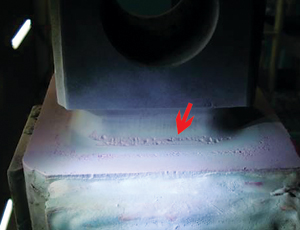For every construction accident, safety experts say, as many as 100 near- misses occur. A quick response this year at the Blue Cross-Blue Shield building in Chicago is an example of one such accident averted.
On Jan. 21, crews were building a $270-million vertical “extension,” adding 24 floors onto the existing, occupied 33-story building. An operator was swinging a Potain MR605B luffing jib to make a pick. That’s when workers heard a loud “pop” and got concerned, according to a source involved with the project, who asked not to be named. Rather than pushing on, the operator “dogged” off the controls and climbed down to inspect.



The general contractor, Chicago-based Walsh Construction Co., consulted with the crane owner, Cleveland-based ALL Erection & Crane Rental Corp., and stopped work. Inspectors from the city and the manufacturer came to the scene. What they found was a cracked corner connector on one crane’s mast section.
The crane stood on three of its four “legs” for several days as officials with the Manitowoc, Wis.-based crane maker, Manitowoc Co., provided a welding procedure. Other risks were promptly addressed. “While all agreed that it was not necessary to evacuate the building, we did vacate the premises at the end of the day so that repairs could be made in the safest way possible,” says Ross Blackstone, a spokesman for the Chicago-based building owner, Health Care Service Corp.
Because the crane already was scheduled for dismantling that week, the incident did not hurt the schedule. The unusual, complicated project was— and still is—due to wrap next year. Also, the Occupational Safety and Health Administration was not called to the scene because no one was injured. “We did become aware of it, but not until some months after,” says Gary Anderson, OSHA area director.
While teamwork and swift decision-making most likely averted a potential disaster, the investigation into why the crane failed is not over. Forensic work continues, and reports are expected this summer.
“We’ve never had a problem like this before,” says Frank Bardonaro, president and COO of Bensalem, Pa.-based AmQuip Crane Corp. “Anything that can potentially cause a catastrophe is a huge deal.” AmQuip runs more than 100 tower cranes nationwide, about half of which also are the French-made Potain type.
“Anytime you have something like this, you look and see if it’s symptomatic,” adds Glen Tellock, Manitowoc’s president and CEO. “That’s what we are looking at right now.” On Feb. 26, Manitowoc issued a letter to crane dealers and owners, saying it did not know the root cause of the Blue Cross incident but that it was an “isolated” event. The cranes can “be safely operated if they have been installed and are operated in accordance with the instructions and limitations contained in our operator’s manuals,” the letter said.
On March 13, Manitowoc issued Service Bulletin G09-T2, calling for domestic crane owners to inspect all similar mast components the next time they are dismantled. Under scrutiny was a factory weld between the steel mast leg and a casting that forms an upper-male connector (see photos). Discontinuities, pitting corrosion or scratched paint could compromise the connector and “accelerate fatigue,” the note said. Manitowoc is paying for these inspections, Tellock adds.
Defects can creep into production and are often overlooked after a company is acquired, safety experts say. “As cranes go from one manufacturer to another…they ought to go over it with a fine-tooth comb,” says David MacCollum, a Sierra Vista, Ariz.-based safety consultant. Manitowoc purchased Potain in 2001.
While some investigators have not yet ruled out defects, early signs point to misuse. One theory is that the steel building was plumbed up without readjusting crane tie-ins, causing the mast to torque and lose strength, says Bardonaro. The No. 1 reason for tower-crane accidents is not following manufacturers’ instructions, adds Terry McGettigan, a San Diego-based crane technician. In addition to operator skill, the top-five tower-crane risks are poor safety management, superintendent oversight, maintenance management and wind, according to a recent report.
So far, no other mast problems have been found, says Bardonaro, whose firm inspected over 1,000 connectors. The incident “may shed light on some other procedures that aren’t currently being used,” he says, such as semi-annual, nondestructive testing of crane components.
While the potential failure of a $1-million crane is cause for alarm, crane owners have other towering concerns: the economy. “The fact is tower-crane utilization in the U.S. has gone from over 80% down to 40%,” says Bardonaro. “I can assure you that every tower crane going up and down across the country is being done by the best people because they don’t have anything else to do.”
Project officials declined to comment, but sources confirm that this was not the first near-miss at Blue Cross. Last year, a sling holding a hook block snapped. The chunk of steel fell through the roof and landed in an empty conference room. Luckily, no one was hurt.


Post a comment to this article
Report Abusive Comment